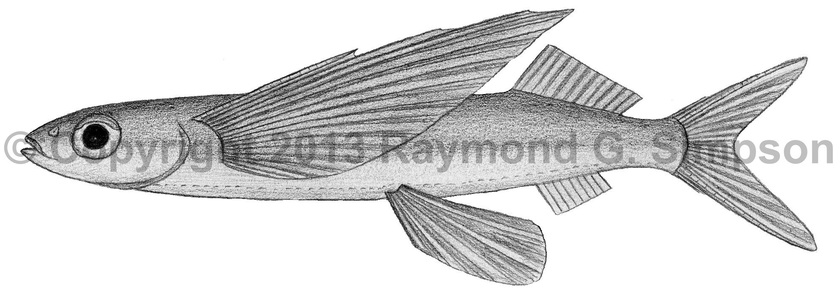
Common Name
Western Bluntnose Flyingfish
Year Described
Parin, 1999
Identification
Dorsal Fin: 11-13
Anal Fin: 8-10 (usually 9)
Pectoral Fin: 15-19
Gill Rakers: 21-28 (first arch)
Predorsal Scales: 20-25
Transverse Scale Rows: 6.5-8
Vertebrae: 42-44
Body elongate with a rectangular cross-section. Head length 3.7-7.1 in SL. Eye diameter 3.0-3.6 in HL and 1.4-1.7 in post-orbital head length. Jaw teeth small and conical. Lower jaw slightly shorter than upper; jaw protrusible. Palatine teeth absent. Pectoral fins long (1.4-1.6 in SL) with first two rays unbranched, fin reaching to caudal fin base. Pelvic fins long (2.8-3.4 in SL), reaching well beyond anal fin origin, with pelvic origin nearer to anal fin than pectoral fin base. Dorsal fin low (longest ray more than 10 times in SL). Origin of anal fin behind dorsal fin (under 4-5th ray). Caudal fin forked with the lower lobe longer than upper. Lateral line low on side. Pectoral branch of lateral line absent. Juveniles robust and stout, with enlarged pelvic fins and no chin barbel(s).
Color
Dark metallic blue above, abruptly paler below. Pectoral fins brown, with a pale distal tip and margin. Dorsal and caudal fins gray. Anal fin transparent. Pelvic fins grayish. Small juveniles (<30mm) very dark overall. Larger juveniles (30-130mm) with uniformly dark pectoral fin.
Size
Maximum size to 18cm SL.
Habitat
Pelagic in neritic waters. Zooplanktivorous with pelagic eggs.
Range
Continental: between 40°N and 40°S over continental margins from the U.S. east coast to Brazil, including the Caribbean Sea and Gulf of Mexico.
References
Parin, N.V. 2002. Exocoetidae (pp 1116-1134). In: Carpenter. 2002. The living marine resources of the Western Central Atlantic. Vol. 2: Bony fishes part 1 (Acipenseridae-Grammatidae). FAO Species Identification Guides for Fisheries Purposes. American Society of Ichthyologists and Herpetologists Special Publication No. 5.
Other Notes
This and Prognichthys glaphyrae were split from P. gibbifrons, which is restricted to the eastern Atlantic but may occur off Brazil as rare vagrants.